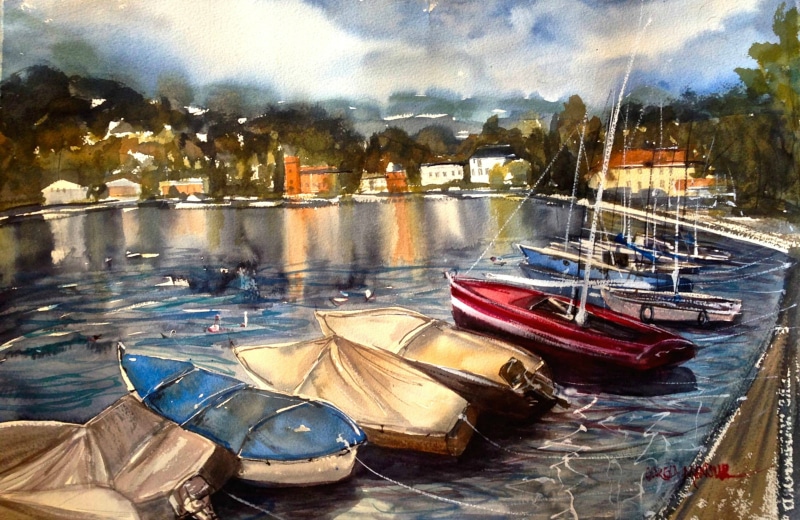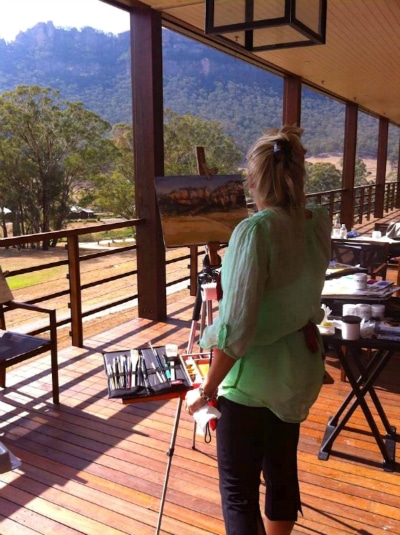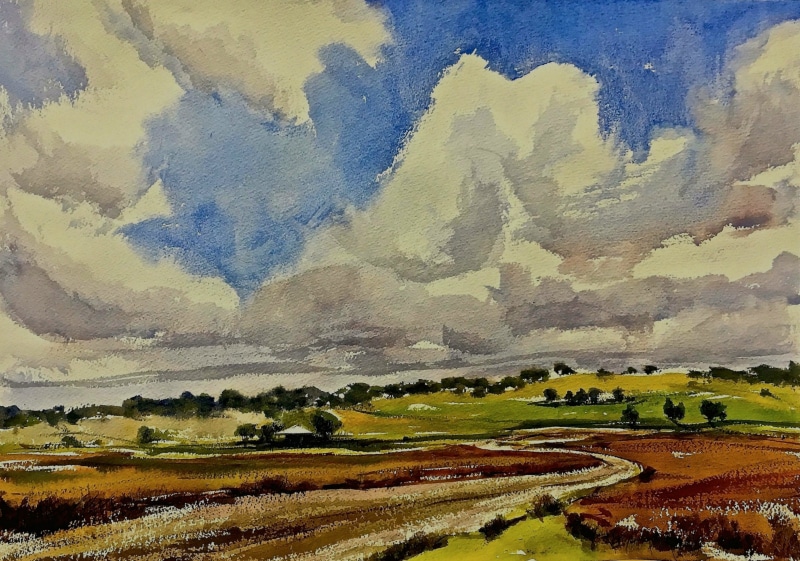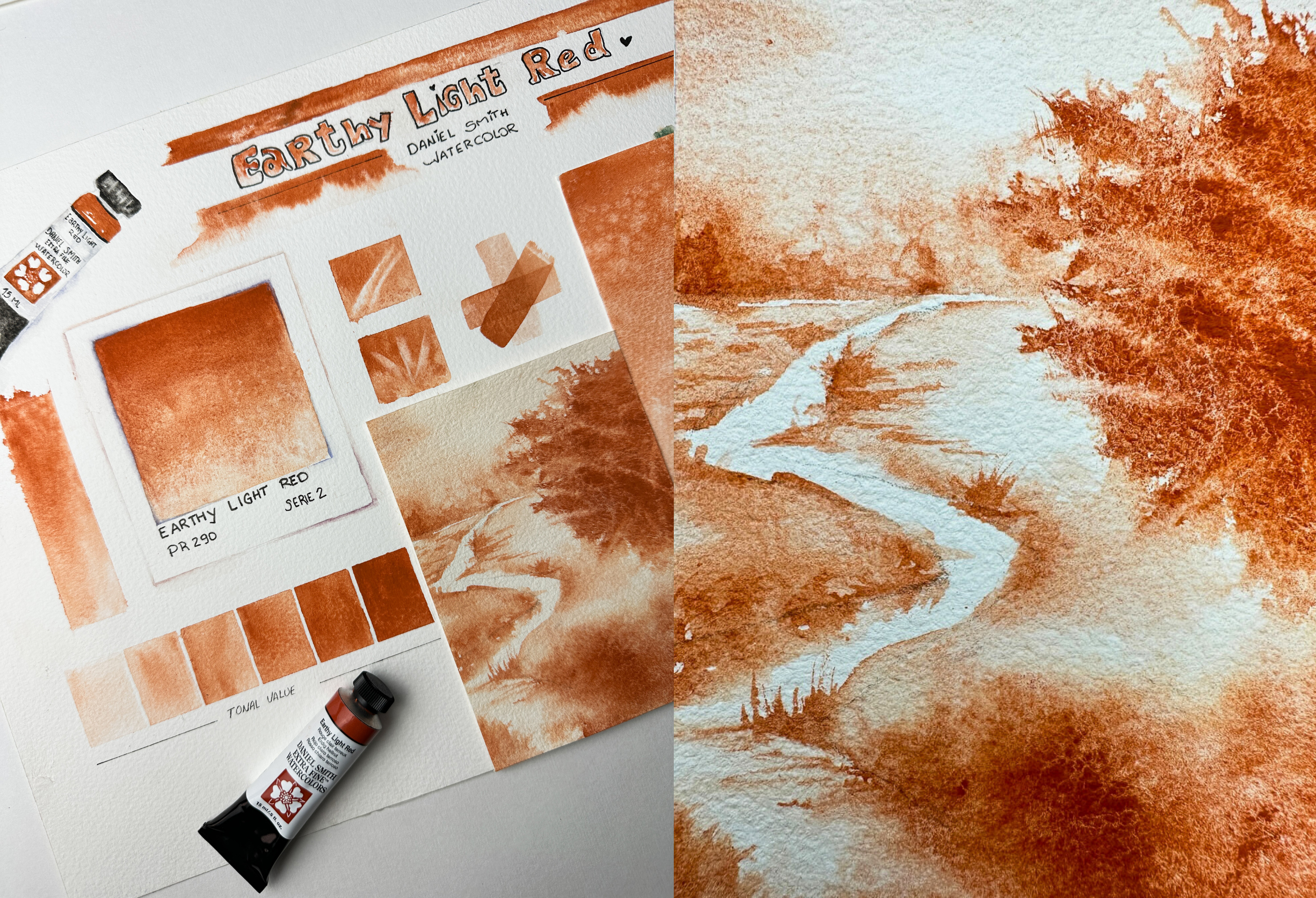
Vườn nho Vista
Tôi muốn cung cấp cho bạn một số mẹo giúp bạn nhanh chóng bắt đầu hành trình vẽ ngoài trời và tránh mắc phải một số lỗi kinh điển của người mới bắt đầu. Tôi muốn xua tan nỗi sợ hãi trong những cuộc phiêu lưu vẽ ngoài trời của bạn và giúp bạn thoải mái, để bạn có thể vẽ như một người chuyên nghiệp!

Màu nước là một trong những hình thức hội họa đẹp nhất và biểu cảm nhất, và nhiều người sẽ nói rằng đây là chất liệu khó thành thạo nhất. Một trong những niềm vui của tôi khi giảng dạy là cơ hội chia sẻ một số công cụ và "bí quyết" tuyệt vời giúp phá vỡ nỗi sợ khi làm việc với màu nước, giúp mọi người dễ tiếp cận hơn với chất liệu thú vị này.
Với một chút cấu trúc để tạo nên khuôn khổ cho bức tranh, bạn sẽ có nhiều tự do hơn để sáng tạo hơn và để chất liệu này phát huy tác dụng kỳ diệu của nó.
Mỗi lần tôi dạy một buổi hội thảo, tôi lại được nhắc nhở rằng có một mức độ lo lắng rất cao trong số các học viên trước khi chúng tôi bắt đầu. Nỗi sợ hãi là thứ duy nhất ngăn cản chúng ta phát huy hết tiềm năng của mình. Điều này thể hiện ở năng lượng tiêu cực – giọng nói trong đầu bạn gợi lên sự bất an rằng chúng ta sẽ không đủ giỏi, nghi ngờ về những gì bạn đang làm, những câu hỏi như "liệu mình có phải là người ít kinh nghiệm nhất trong lớp này không" hoặc "liệu mình có trông ngốc nghếch không?" Hãy yên tâm, tôi cũng đã từng cảm thấy như vậy ~ khi tôi bắt đầu trình diễn, tôi nghĩ rằng mọi người đang xem đều có thể nghe thấy tiếng tim tôi đập thình thịch trong lồng ngực!
Khi bạn hiểu rằng những cảm xúc này hoàn toàn bình thường và bạn không đơn độc trong việc cảm thấy điều này, việc học tập thực sự và sự phát triển cá nhân thực sự có thể bắt đầu. Những người có thể chấp nhận và thừa nhận những cảm xúc này hiện hữu, nhưng vẫn tiếp tục tiến về phía trước và vượt qua chúng, sẽ nhận được mật ngọt của sự phát triển và thành công.
Vì vậy, nếu bạn cảm thấy không thoải mái ngay bây giờ, thì không sao cả. Chỉ cần ngồi xuống và để nó cuốn trôi bạn để bạn có thể ra vùng nước sâu hơn và cưỡi con sóng lớn đó cho đến tận bờ. Hãy để nỗi sợ hãi mà bạn cảm thấy là năng lượng mà bạn khai thác để đưa kỹ năng của mình lên một tầm cao mới. Sáng tạo thực sự cần có lòng dũng cảm, vì vậy hãy tự chúc mừng bản thân vì đã thực hiện bước tiến lớn này để cải thiện kỹ năng của mình và biết rằng thế giới của bạn sắp bị rung chuyển!

Thuyền trên Hồ Como
Điều tôi khám phá ra là hội họa đã dạy tôi mọi thứ tôi cần biết về cuộc sống. Nó đã dạy tôi khi nào thì kiên nhẫn, khi nào thì nhảy vào, với cả giày và tất cả, tính kỷ luật, chấp nhận rủi ro, cách giao tiếp và kết nối với người khác, và sự khiêm nhường. Ồ, nó đã từng dạy tôi sự khiêm nhường chưa – hết lần này đến lần khác. Nhưng bằng cách chấp nhận thất bại, hoặc trong trường hợp này, tạo ra nghệ thuật tệ hại trong mục tiêu cao cả hơn là tạo ra nghệ thuật đáng kinh ngạc, chúng ta phải gạt bỏ cái tôi của mình lại phía sau và mạo hiểm tất cả. Nếu chúng ta cứ tiếp tục chơi nhỏ bằng cách làm những gì chúng ta biết mình có thể làm, quá trình phát triển của chúng ta sẽ trì trệ và chúng ta sẽ không bao giờ tiến bộ.
Vậy nên ở đây tôi mời bạn hãy lắng nghe với một trái tim rộng mở ~ ngay cả khi bạn nghĩ rằng bạn đã biết đôi chút về bất cứ điều gì tôi đang nói, hãy cố gắng lắng nghe và đi sâu vào những gì tôi đang dạy. Bạn có thể tìm thấy sự hiểu biết sâu sắc hơn về các khái niệm mà bạn đã biết và bạn có thể tiếp cận được chìa khóa mở ra cánh cửa đến cấp độ tiếp theo trong hành trình vẽ tranh của riêng bạn. Có thể mất một thời gian để bạn thực hiện điều đó trong tác phẩm của riêng mình, nhưng sự hiểu biết đến trước khi thực hiện.
Chúng ta thường làm việc ở mức độ hiểu biết ít ỏi và một số thành công, nhưng sự thành thạo mà chúng ta hy vọng có vẻ khó nắm bắt và khó nắm bắt. Đôi khi thành công trong hội họa của chúng ta có thể thành công hoặc thất bại, vì vậy tôi hy vọng bạn sẽ có được một số mảnh ghép quan trọng của câu đố về kinh nghiệm của riêng bạn thông qua những gì bạn học được ở đây. Điều quan trọng nhất là lắng nghe bằng một tâm trí và trái tim rộng mở, và sự tiến bộ của bạn chắc chắn sẽ theo sau. Xin hãy biết rằng bạn không đơn độc trong việc cảm thấy lo lắng hoặc không thoải mái, nhưng tôi hứa với bạn rằng bạn sẽ có được cái nhìn sâu sắc về quá trình vẽ tranh để có được kết quả mà bạn yêu thích.
Chìa khóa ở đây là bạn sẵn sàng bước ra khỏi vùng an toàn quen thuộc và thử những điều bạn học được ở đây. Quãng đường cọ vẽ sẽ là thứ mang lại thành quả nghệ thuật, nhưng với sự hướng dẫn tốt và nền tảng vững chắc, bạn sẽ tìm thấy bước tiến và giọng nói nghệ thuật của mình nhanh hơn nhiều.

Jackson Hole bên bờ suối
Bây giờ để giải quyết cơ chế và quy trình thành công của màu nước trong lĩnh vực này… hãy ra ngoài! Mẹ thiên nhiên là người thầy tuyệt vời nhất và bạn có tất cả thông tin cần thiết ngay trước mắt, nếu bạn biết phải tìm kiếm điều gì.
Vẽ tranh ngoài trời rất khác với vẽ tranh trong studio, nơi bạn có mọi tiện nghi và vật liệu trong tầm tay. Nhưng đây hoàn toàn là cách TỐT NHẤT để cải thiện tác phẩm của bạn. Vẽ tranh ngoài trời buộc bạn phải đánh giá tình hình, đưa ra một số quyết định điều hành quan trọng một cách nhanh chóng và cô đọng những gì bạn đang nhìn thấy và trải nghiệm thành một khoảnh khắc trong thời gian. Nó dạy bạn cách phản ứng ngay tại thời điểm đó và nhanh chóng nắm bắt được bản chất của những gì thu hút sự chú ý của bạn.
Và đoán xem sao? Nếu bạn có thể làm được điều đó, bạn cũng có thể thu hút sự chú ý của người xem vì Bạn hãy quyết định điều gì là quan trọng trong bức tranh của bạn! Bạn trở thành người kể chuyện, dẫn dắt người xem vào và xuyên suốt bức tranh của bạn và để họ nhìn thấy bên trong thế giới của bạn. Đây là cách chúng ta thể hiện bản thân và chia sẻ cảm xúc mà những trải nghiệm của chúng ta mang lại. Chúng ta rất vinh dự khi có thể chia sẻ sự thể hiện sáng tạo và giọng nói trực quan của mình. Đây là điều mà chỉ bạn mới có thể làm được từ góc nhìn độc đáo của mình, vì vậy đừng ngại để ánh sáng của bạn tỏa sáng!

Georgia trình diễn vẽ tranh ngoài trời tại Thung lũng Wolgan
Đồ dùng ngoài trời
Tôi đã thử nhiều cách sắp xếp giá vẽ khác nhau trong nhiều năm, nhưng cuối cùng tôi đã tìm thấy một cách phù hợp nhất với mình. Không có gì tệ hơn cảm giác như bạn đang vật lộn với một con bạch tuộc nặng nề và không hợp tác! Đây là một quyết định rất cá nhân, vì vậy hãy kiểm tra các đợt giảm giá và chọn loại phù hợp với bạn ~ bạn có thể sẽ phải hôn một số con ếch trước khi tìm thấy hoàng tử của riêng mình. Có nhiều loại giá vẽ để lựa chọn và bạn sẽ cần phải suy nghĩ về trọng lượng của nó nếu bạn đi bộ đường dài nhiều ~ bạn cần có thể tự mình mang tất cả. Xin lưu ý - nếu bạn làm việc từ cửa sau xe của mình, trọng lượng có thể không phải là vấn đề, nhưng tôi khuyên bạn nên cắt giảm vật liệu của mình để nhẹ nhất có thể ~ ít hơn là nhiều hơn.
Tôi chủ yếu sử dụng Strada Mini trên chân máy vì nó chắc chắn và nhẹ, và có thể chịu được nhiều tác động khi đi du lịch khoảng 8 tháng trong năm để giảng dạy trên khắp thế giới. Nó không có bất kỳ ốc vít hay bu lông nào để loay hoay và có thể xếp gọn gàng trong ba lô của tôi với các cánh có thể tháo rời.
Chân máy của tôi nhẹ nhưng chắc chắn với một tấm tháo lắp nhanh và chân có thể khóa để định vị, giúp thời gian thiết lập và tháo lắp cực kỳ nhanh chóng và dễ dàng. Tôi sẽ tránh các chân ống lồng xoắn, vì chúng có xu hướng rơi ra hoặc kẹt lại theo thời gian. Tin tôi đi, bạn muốn sẵn sàng đóng gói ngay lập tức nếu thời tiết đột nhiên thay đổi!
Vì tôi dạy nhiều loại phương tiện nước (màu nước, acrylic và dầu hòa tan trong nước), tôi thay đổi 3 bảng màu giống hệt nhau tùy thuộc vào nội dung tôi trình bày. Về cơ bản, tôi sử dụng cùng một màu trong tất cả các phương tiện.

Tu viện 2
Điều đầu tiên bạn cần làm là dựng giá vẽ ở nơi an toàn (không phải quay lưng về phía đại dương hoặc trên vách đá có đá trơn trượt). Mặc dù nghe nhạc rất thú vị, nhưng đeo tai nghe sẽ cản trở khả năng nghe của bạn về các phương tiện, người, máy móc hoặc động vật đang đến gần.
Nếu bạn ở trong khu vực có ve, cây sồi độc hoặc các loại côn trùng khác, hãy bảo vệ bản thân bằng cách che da hoặc sử dụng thuốc chống côn trùng. Bạn nên biết về hệ thực vật và động vật ở khu vực bạn sẽ sơn, vì đôi khi bạn cần mang theo bình xịt hơi cay hoặc bình xịt gấu/nai sừng tấm, đi ủng hoặc chuẩn bị sẵn bộ dụng cụ sơ cứu rắn cắn. Mang theo điện thoại cũng là một ý tưởng hay nếu bạn đi một mình nhưng tất nhiên hãy đảm bảo rằng bạn đang ở trong khu vực có dịch vụ.
Điều tiếp theo là kiểm tra xem bảng màu và bức tranh của bạn có cùng độ sáng không ~ cố gắng đặt ở nơi râm mát (tránh ánh sáng lốm đốm) hoặc nếu có thể, hãy đặt ở nơi có mái che để tránh thời tiết.
Nếu không thể, bạn có thể đầu tư vào một chiếc ô gắn vào giá vẽ hoặc gắn giá vẽ và giá đỡ tranh bằng một miếng dán velcro chắc chắn khi có gió lớn. Tôi cũng sử dụng túi đựng đồ của mình để đựng rác và bất kỳ thứ gì khác mà tôi có thể cần làm vật đối trọng treo trên giá vẽ, giúp giá vẽ ổn định và không bị gió thổi bay. Đôi khi tôi thay cột buồm bằng một bức tranh lớn hơn khi tôi biết rằng gió sẽ không biến bức tranh của tôi thành một con diều!
Tôi cảm thấy ô chỉ là một thứ cần mang theo….vì vậy tôi thường chọn mũ rộng vành và kem chống nắng. Tôi không đeo kính râm vì chúng ảnh hưởng đến khả năng đánh giá giá trị và màu sắc phù hợp của tôi. Hãy lưu ý rằng quần áo màu đậm có thể phản chiếu lên bức tranh của bạn và ảnh hưởng đến khả năng đánh giá màu sắc của bạn, vì vậy quần áo trung tính là một lựa chọn tốt.
Đảm bảo bạn có đủ nước để giữ cơ thể đủ nước cũng như đủ nước để pha sơn ~ Tôi sử dụng một thùng chứa có 2 lỗ ~ một lỗ để đựng nước bẩn và một lỗ để rửa lại lần hai để giữ cho màu của bạn sạch và tươi.

Góc nhìn Mudgee của tôi
Kiểm tra xem bức tranh của bạn có đúng chiều cao để bạn có thể đứng không ~ điều này có nghĩa là phần giữa bức tranh của bạn phải ngang tầm vai. Tôi thực sự khuyên bạn nên đứng thay vì ngồi để vẽ. Bạn sẽ tự do hơn nhiều về cơ thể và có thể sử dụng toàn bộ cơ thể thay vì chỉ dùng tay ~ điều này sẽ khiến bức tranh của bạn trở nên trữ tình hơn, thoải mái và tự do hơn. Tôi khuyến khích bạn nhảy múa với cọ vẽ của mình và đắm mình hoàn toàn vào quá trình này. Vẽ tranh ngoài trời có thể rất vui và thú vị, đừng tước đi trải nghiệm trọn vẹn của bạn!
Ngồi khiến chúng ta bị hạn chế tầm nhìn và tách mình ra khỏi bối cảnh, ẩn sau bức tranh và không nhìn nhận đúng bối cảnh. Đứng cũng mang lại cho bạn lợi ích to lớn là rời xa bức tranh và có được góc nhìn đúng đắn. Trên thực tế, tôi khuyến khích học viên của mình lùi lại 10-20 feet so với bức tranh của họ khoảng 8 phút một lần. Điều này đảm bảo rằng bạn đang thực hiện bức tranh của mình một cách toàn diện và có thể thấy liệu có bất kỳ điều gì mất cân bằng hay không và bạn không thể làm tốt điều này khi ngồi. Nó cũng buộc bạn không nên quá căng thẳng và lạc vào các chi tiết trước khi đến lúc! Chỉ cần nhớ nhìn vào nơi bạn đang lùi lại….chúng ta không muốn kết thúc ở đại dương hoặc tệ hơn!
Đừng để bị đe dọa bởi những chủ đề khác với chủ đề bạn thường vẽ. Chìa khóa để vẽ tại địa điểm là tách biệt những gì bạn muốn vẽ qua ống ngắm và quên đi mọi thứ khác không nằm trong tầm nhìn của bạn. Đừng để sự kích thích quá mức của tất cả các giác quan cản trở cảm xúc và phản ứng chân thực của bạn đối với cảnh của bạn.

Boogie dưới ánh mặt trời
Nếu bạn có thể đơn giản hóa mọi thứ bạn nhìn thấy thành một mô hình hình dạng và giá trị, không có chủ đề nào nằm ngoài tầm với của bạn. Bắt đầu với các hình dạng hữu cơ và tiến dần đến các chủ đề nhân tạo khi bạn tự tin hơn. Và nếu bạn cảm thấy hoàn toàn choáng ngợp trước thế giới ngoài trời tuyệt vời, hãy quay lại với điều gì đó đơn giản, như tập trung vào một bông hoa hoặc một thứ gì đó không quá đáng sợ lúc đầu. Những thành công của bạn sẽ giúp bạn tự tin hơn để giải quyết tất cả các chủ đề bạn nhìn thấy. Có lẽ bạn chỉ muốn tập trung vào việc thực hiện một số nghiên cứu giá trị cơ bản trong sổ phác thảo của mình để khởi động, bất cứ điều gì hiệu quả với bạn.
Tôi thực hiện hầu hết các bức tranh của mình theo ba giai đoạn:
- Lên kế hoạch và sáng tác, hoàn thiện lớp sơn lót trong khi vẫn giữ được màu trắng
- Tập trung vào các giá trị, cấu trúc và tâm trạng thông qua màu sắc và nhiệt độ
- Tinh chỉnh chi tiết, thống nhất và kết hợp tất cả lại với nhau
Một điều mà tôi nghĩ nhiều người mới bắt đầu không hiểu rõ là tầm quan trọng của sự nhất quán giữa tỷ lệ sơn và nước. Sau đây là nguyên tắc chung của tôi:
Giai đoạn 1 = Lần rửa đầu tiên có độ sánh như cà phê hoặc trà với một lượng nước vừa phải
Giai đoạn 2 = Tôi sử dụng độ sệt kem, ít nước và nhiều sơn hơn (ướt trên ẩm sẽ tạo ra các cạnh mềm mại)
Giai đoạn 3 = Tôi sử dụng sơn trực tiếp từ tuýp để tạo điểm nhấn cuối cùng (sử dụng sơn ướt vào khô để tạo các cạnh sắc nét cho các vật thể nhân tạo và các chi tiết quan trọng)
Ở giai đoạn 3, tôi muốn đảm bảo rằng ánh sáng và các điểm nhấn thu hút được sự chú ý một cách hiệu quả và quan trọng nhất là đảm bảo điểm nhấn là ngôi sao của chương trình.
Việc nạp cọ đúng cách và kiểm soát tỷ lệ ướt/khô cần một chút luyện tập, nhưng bạn có thể kiểm soát lượng nước bằng cách sử dụng miếng bọt biển để loại bỏ bớt độ ẩm. Cố gắng đảm bảo rằng bạn không bắt đầu với cọ đã được nạp một nửa nước sau khi rửa sạch, nếu không bạn sẽ không có được độ đặc cần thiết và sẽ phải vật lộn với rất nhiều bông hoa súp lơ trên bức tranh của mình!

Đồi cát







